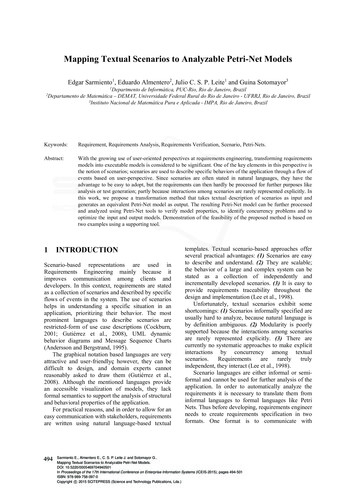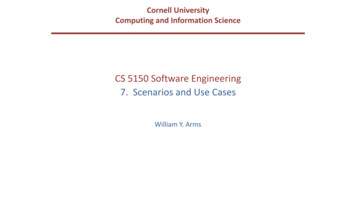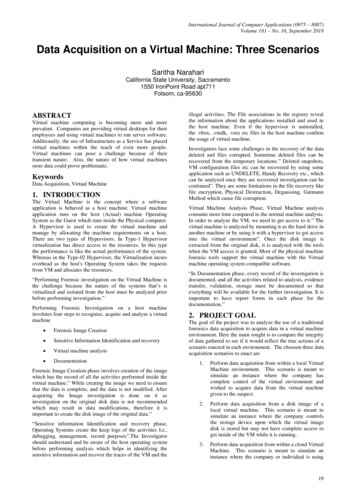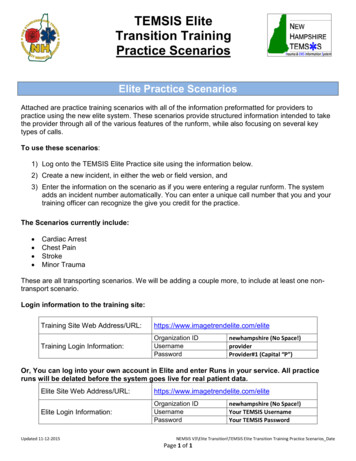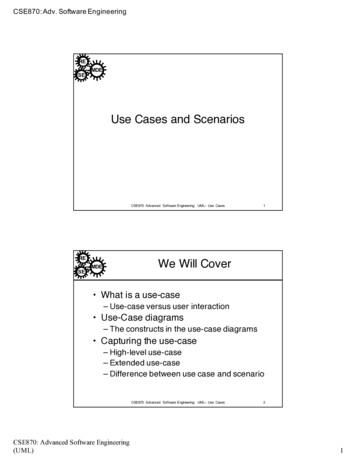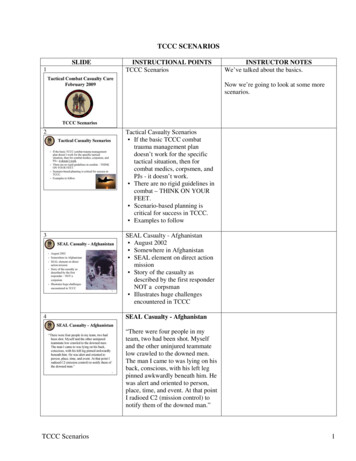
Transcription
TCCC SCENARIOSSLIDE1INSTRUCTIONAL POINTSTCCC ScenariosINSTRUCTOR NOTESWe’ve talked about the basics.Now we’re going to look at some morescenarios.2Tactical Casualty Scenarios If the basic TCCC combattrauma management plandoesn’t work for the specifictactical situation, then forcombat medics, corpsmen, andPJs - it doesn’t work. There are no rigid guidelines incombat – THINK ON YOURFEET. Scenario-based planning iscritical for success in TCCC. Examples to follow3SEAL Casualty - Afghanistan August 2002 Somewhere in Afghanistan SEAL element on direct actionmission Story of the casualty asdescribed by the first responderNOT a corpsman Illustrates huge challengesencountered in TCCC4SEAL Casualty - Afghanistan“There were four people in myteam, two had been shot. Myselfand the other uninjured teammatelow crawled to the downed men.The man I came to was lying on hisback, conscious, with his left legpinned awkwardly beneath him. Hewas alert and oriented to person,place, time, and event. At that pointI radioed C2 (mission control) tonotify them of the downed man.”TCCC Scenarios1
SLIDE5INSTRUCTIONAL POINTSSEAL Casualty - AfghanistanINSTRUCTOR NOTES“Upon closer inspection, his kneewas as big as a basketball and hisfemur had broken. The patient wasin extreme pain and did not allowme to do a sweep of his injured leg.He would literally shove me or grabme whenever I touched his leg orwounds. I needed to find theentrance and exit wound and stopany possible arterial bleeding.”6SEAL Casualty - Afghanistan“But there was zero illuminationand he was lying in a wet irrigationditch. So I couldn’t see blood and Icouldn’t feel for blood.”7“Picture yourself in this situation. You’vegot a casualty who is badly hurt and youcan’t see a thing.”SEAL Casualty - Afghanistan“We were also in danger becauseour position was in an open field(where the firefight had been) and Ihad to provide security for him andmyself. So, I couldn’t afford to turnon any kind of light to examine hiswounds. I told him to point towhere he felt the pain. He had tosort through his pains.”8SEAL Casualty - Afghanistan“He had extreme pain in his kneeand where his femur had beenshattered as well as a hematoma atthe site of the entrance wound(interior and upper left thigh).Finally, he pointed to his exitwound (anterior and upper leftthigh). Again, I had no way oftelling how much blood he had lost.But I did know that he wasnonambulatory.”TCCC Scenarios2
SLIDE9INSTRUCTIONAL POINTSSEAL Casualty - AfghanistanINSTRUCTOR NOTESC2 Command and Control“So I called C2 again. I gave himthe disposition of the patient as wellas a request for casevac, aCorpsman, and additional personnelto secure my position and assist inmoving the patient to thehelicopter. I thought about movingthe two of us to some concealment25 meters away, but we were bothreally low in a shallow irrigationditch. I felt safer there than tryingto drag or carry a screaming man toconcealment.”10SEAL Casualty - Afghanistan“Between providing security andspending a lot of time on the radio Ididn’t get to treat the patient asmuch as I wanted to. I had givenhim a Kerlix bandage to holdagainst his exit wound. When hefrantically told me that he wasfeeling a lot of blood, I went backto trying to treat him. I couldn’televate his leg. To move it wouldmean he’d scream in pain, whichwasn’t tactical.”11SEAL Casualty - Afghanistan“There was just no way he wouldallow me to apply a pressuredressing to the exit wound even if Icould locate it and pack it withKerlix. So, I decided to put atourniquet on him.”TCCC Scenarios3
SLIDE1213INSTRUCTIONAL POINTSSEAL Casualty - AfghanistanINSTRUCTOR NOTESNote the makeshift tourniquet.“His wounds were just low enoughon his leg to get the tourniquet aninch or so above the site. I had acravat and a wooden dowel with550 cord (parachute cord) attachedto it to use as a tourniquet. I toldhim to expect a lot of pain as Iwould be tightening the cravatdown.“When we first started the war inAfghanistan, most U.S. forces were notdeploying with issued tourniquets.SEAL Casualty - AfghanistanYou need to be able to get a tourniquet ona wounded teammate with zeroillumination.“At this point he feared for his lifeso he agreed. Once I got ittightened I had trouble securing it.The 550 cord was hard to getunderneath the tightened cravat.”14SEAL Casualty - Afghanistan“After over 5 minutes, theCorpsman arrived along with aCASEVAC bird and a securityforce. Moving the patient was veryhard. Four of us struggled to movehim and his gear 25 meters to thebird. The patient was over 200pounds alone and we were movingover very uneven terrain.”15SEAL Casualty - Afghanistan“We wanted to do a three-mancarry with two men under his armsand one under his legs. But again,his leg was flopping around at thethigh and couldn’t be used to lifthim.”TCCC ScenariosExperienced combat medical personnelsay that moving the casualty is typicallythe biggest challenge in TCCC.4
SLIDEINSTRUCTIONAL POINTSSEAL Casualty - AfghanistanINSTRUCTOR NOTESWas the tourniquet a good move?“The bird, (a Task Force 160 MH60) had a 50-cal sniper riflestrapped down, which made it hardfor us to get him in. It took usminutes to get him 25 meters intothe bird. The Corpsman went withmy patient as well as the otherdowned man in my team and I wentback to the op.”Absolutely – probably saved thecasualty’s lifeScenario Discussions – SuggestedFormat Break up into groups of six Present the background for thescenario on the screen. Let the instructor take it fromthere using his TCCC ScenarioInstructor’s Guide and talkingthe group through the scenario. 10 minutes per scenario Stop after 10 minutes andpresent the next scenario onscreen.Here’s is a suggested format for thescenario discussions18Urban Warfare ScenarioNow let’s look at a scenario in urbanwarfare operations19October 1993 High-threat urban environment 16-man Ranger team 70-foot fast rope insertion forbuilding assault One man misses rope and falls Unconscious on the ground Bleeding from mouth and ears Unit taking sporadic fire fromall directions from hostilecrowdsAnybody recognize this casualty?1617TCCC ScenariosWould a pressure dressing have been agood idea if tolerated by the patient?NO – won’t necessarily stop a big bleederGet the class talking and thinking onthese!First Ranger casualty in MogadishuEverybody here see “Blackhawk Down?”5
SLIDE202122TCCC ScenariosINSTRUCTIONAL POINTSThe Battle of Mogadishu Somalia – 3 October 1993 US casualties: 18 dead, 73wounded Estimated Somali casualties 350dead, 500 wounded Battle 15 hours in lengthINSTRUCTOR NOTESAt the time, it was the biggest battleinvolving U.S. forces since VietnamMogadishu Complicating Factors Helo CASEVAC not possiblebecause of crowds, narrowstreets, and RPGs Vehicle CASEVAC not possibleinitially because of ambushes,roadblocks, and RPGs Gunfire support problems Somali crowds included noncombatants Somalis able to take cover inbuildings RPG threat to helo firesupport gunshipsWe talked about factors that makeevacuation by helicopter hard.Care under Fire Return fire? Move patient to cover rightaway or wait for long board? How should he be moved? Intubation? IV fluids? Urgency for evacuation?See below for Instructor NotesPicture is of Mogadishu streetBe sure that you add narrow streets andRPG fire to that list.There were LOTS of U.S. helos overMogadishu, but we were not able to evacthe casualties with them for these reasons.6
SLIDEINSTRUCTIONAL POINTSINSTRUCTOR NOTESShould the medic return fire or care for casualty?Does he need to be intubated?NoReasonable to have medic or corpsman to attendChin-lift/jaw-thrust and NP airwaycasualty in this scenarioWhy?Total suppression of hostile fire not possibleLarge crowd – can’t kill everybodyLots of other gunsCritically injured patientDoes he need IV fluids?Probably notMay make head injury worseOnly needs fluid resuscitation if internal bleeding andhypovolemic shockDoes that break our rule about shooting first andtreating later?Check radial pulse – give fluids if pulse weakYes - but that’s OK – it’s the right answer for thisparticular situation.What’s next?Move patient to cover right away or wait for longboard immobilization?Is he at risk for a spinal injury if moved? YesAlso very much at risk of getting shotProbably DO want to get him to cover immediately –cover available at sideof roadUrgency for evacuation?Little that can be done at FST (forward surgical team)for the head injuryPossible ruptured spleen or other internal bleeding maybe bigger issueTactical commander in Mogadishu split force ratherthan wait 30 minutesDoes he need antibiotics or analgesia?No – no open wound notedAlready unconsciousOutcomeRanger survived his injuries.End of scenarioHow would you want to move him?Carefully!!Cradle head with forearms to stabilize neck and drag23Mogadishu Scenario 2 Helo Hit byRPG RoundSecond real-world scenario fromMogadishuVery different tactical situationTCCC Scenarios7
SLIDE24INSTRUCTIONAL POINTSMogadishu Scenario 2 Helo Hit byRPG Round Hostile and well-armed (AK47s, RPG) crowds in an urbanenvironment Building assault to capturemembers of a hostile clan Blackhawk helicopter trying tocover helo crash site Flying at 300 foot altitude25Mogadishu Scenario 2 Helo Hit byRPG Round Left door gunner with 6 barrelM-134 minigun (4000 rpm) Hit in hand by ground fire Another crew membertakes over mini-gun RPG round impactsunder right door gunner26Mogadishu Scenario 2 Helo Hit byRPG Round Windshields all blown out Smoke filling aircraft Right minigun not functioning Left minigun without a gunnerand firing uncontrolled Pilot: Transiently unconscious now becoming alert27Mogadishu Scenario 2 Helo Hit byRPG Round Co-pilot Unconscious - lying forwardon helo’s controls Crew Member Leg blown off Lying in puddle of his ownblood Femoral bleedingTCCC ScenariosINSTRUCTOR NOTES8
SLIDE28INSTRUCTIONAL POINTSMogadishu Scenario 2 Helo Hit byRPG Round YOU are the person providingcare in the helo. What do you do first?What are your options for first actions?Casualty with femoral bleedingUnconscious co-pilotSemi-conscious pilotStop the uncontrolled min-gun from firingINSTRUCTOR NOTESSee below for Instructor NotesThe individual in Mogadishu treated himselfUsed an improvised tourniquet SurvivedWhat can you do for the unconscious co-pilot?Get him off the controlsSupine position and establish airway with NPACheck for external bleeding – none seenWho gets treated first?Take care of the pilot firstWant to get him back flying the aircraftMost important thing about medical care in an aircraftis to try to keep the aircraft in the airStimulate pilot by shakingSmelling salts if availableWhat’s next?Casualty with the femoral bleeder is nextNeeds a tourniquetHe should be able to provide self-care if conscious29TCCC ScenariosNext action?Check casualty with injured handStop any severe bleedingWhat else?Radio for helpPrepare for impact if crash landing anticipatedAfter impact – security for weapons and ordnanceEnd of scenarioMilitary Operations in UrbanTerrainNow let’s look at a few scenarios that arerepresentative of the kind that we areseeing in Iraq at present9
SLIDE30INSTRUCTIONAL POINTSMOUT Scenario 1 A U.S. ground element ismoving on a high-value target inan urban environment The first two men in a 8-manpatrol are shot by an individualwith an automatic weapon whilemoving down a hallway in abuilding. The attacker follows this burstwith a grenade.31MOUT Scenario 1 One casualty is shot in theabdomen but conscious. The second casualty is shot inthe shoulder and has massiveexternal bleeding from thewound. The third person is unconsciousfrom the grenade blast. The attacker withdraws around acorner.32MOUT Scenario 1 YOU are the person providingmedical care. What do you do?TCCC ScenariosINSTRUCTOR NOTESSee below for Instructor Notes10
SLIDEINSTRUCTIONAL POINTSINSTRUCTOR NOTESCheck for other injuriesWhat are the tactical considerations here?How many other hostiles in are in house?All pursue hostile – leave casualties for later?All withdraw to care for casualties?Set security and treat casualties there?Split force – have some pursue and others treat?Split force most often chosen as the best option fromprevious groups.Who gets treated first?Casualty with Shoulder InjuryMost important to treat immediately – could bleed todeath quicklyStop bleeding with Combat Gauze dressingApply with direct pressure for 3 minutesAirway Management?OK – consciousIV?No – not in shock if take care of bleeding withoutdelayCombat pill pack?YesFentanyl?Careful - may go into shock later from shoulder woundWhat next?Unconscious Casualty with Blast InjuryAirway Management?Chin-lift/jaw thrustNP airway33TCCC ScenariosFind major bleeding in back of thigh from shrapnelwoundApply tourniquetIV fluids?Check radial pulse – strong – not unconscious fromhemorrhageNo need for fluids – may make blast lung worseUnconscious from blastPulse ox monitoringMust prevent hypoxia in TBI casualtiesCombat pill pack?No – needs IV antibiotics – unconscious – medicalpersonnel administer when feasibleNeeds oxygen in CASEVAC phaseNext?Abdominal Wound CasualtyAirway Management?OK - consciousIV fluids?No, not at present – not in shockSaline lock a good idea when time permitsMay go into shock laterCombat pill pack?Yes – casualty can self-administerAbdominal wound should have IV antibiotics – but notthe first priority at this pointEnd of scenarioMOUT Scenario 211
SLIDE3435TCCC ScenariosINSTRUCTIONAL POINTSMOUT Scenario 2 SCENARIO HISTORY: Whileon patrol in the city of Tal Afaryour platoon receives effectivedirect small arms fire. A 22year-old unit member falls to theground and begins screaming,holding his right leg. Theplatoon, including you, reacts tothe ongoing contact by returningfire.MOUT Scenario 2 You can see that the casualty isbleeding heavily from his legwound. YOU are the person providingmedical care for the unit. What do you do?IN
03.10.1993 · RPG round impacts under right door gunner . 26 . Mogadishu Scenario 2 Helo Hit by RPG Round Windshields all blown out Smoke filling aircraft Right minigun not functioning Left minigun without a gunner and firing uncontrolled Pilot: Transiently unconscious - now becoming alert . 27 . Mogadishu Scenario 2 Helo Hit by RPG Round Co-pilot Unconscious - lying .

